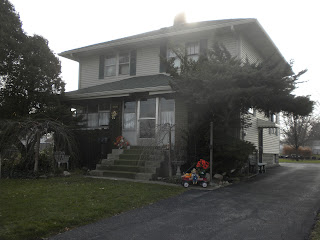Joel F. Richardson, the father of this clan, made a fortune in the railroad business. He began investing and building rail lines as early as 1844 in Massachusetts and New York. Eventually, he moved his family to Delhi, Ohio (near Cincinnati) where he operated a farm and a coal elevator in nearby North Bend. He first came to Indiana in the 1850s and helped to build the Indianapolis-Lawrenceburg Rail Line. He returned in 1870 with the bold idea of building a belt or ring rail line around the city of Indianapolis. Just as he began to find investors for the idea, the Panic of 1873 hit the nation and he saw his fortunes fall. He was saved by John Caven, the mayor of Indianapolis, who thought it was a good idea and helped to raise $500,000 for the construction of the profitable line.
Upon his death in 1895, Joel Richardson willed quite a lot of money and land to his children. His son, Thomas, was an entrepreneur who began to speculate on land and housing in the Irvington area. His firm, Richardson and Porter was likely responsible for building several Irvington homes including: 304 South Ritter Avenue, 346 South Ritter, and 104 Johnson Avenue among many others. It is possible that he built 312 Burgess Avenue, but that is merely speculation at this point. An Indianapolis Star article (July 27, 1911) reported that Mr. Richardson sold eleven vacant lots north of Washington Street and New York Street and east of Audubon Road to Charles Thompson for $12,000. When he suffered a near fatal stroke at the age of 60 on November 14, 1914, the Indianapolis Star called him "one of the most prominent citizens of Irvington." He eventually recovered and lived until 1930.
Ida Richardson was a talented artist and poet. To earn an income, she taught in the public schools. She was known for her brass etchings and china painting. The Indiana Historical Society has many of her scrapbooks, diaries, poetry, and two of her paintings of President Benjamin Harrison's childhood home in North Bend, Ohio. She grew up near his family. She had many passions in life including genealogy. In an age when it was difficult to search one's lineage, Miss Richardson managed to trace her mother's people back to Oliver Cromwell's England. Miss Richardson was also the secretary to the Marion County Agricultural and Horticultural Society for decades beginning in the 1890s. She was also a member of other Irvington clubs as well. Miss Richardson gave many formal talks in her lifetime including one titled, "Weeds and Seeds" on September 15, 1912. She lived most of her life with her younger sister Jennie (Mary J.) at 312 Burgess Avenue. Sometime after 1904, they had the Queen Anne porch removed from the home and added a larger Craftsman era porch.
Ida Richardson lived to the age of 84 years and died in 1932. Her younger sister passed away in 1936. Upon her passing, the home remained vacant through the remainder of 1936 and the rest of 1937. Sometime during that year, the home burned to the ground. For over seventy-five years, no one has rebuilt on the site and the lot now belongs to 304 Burgess Avenue. Both Richardson women and the home have been forgotten.
Thankfully, local historian Larry Muncie, managed to acquire these three historic images of the long lost home. In the top photo, you can see what the home would have looked like in the late nineteenth century. Notice the smaller, but beautiful and ornate front porch. In the second photo, likely taken around 1902, Ida Richardson hosts one of her many club gatherings. In the third photo, you can see either Ida or Jennie Richardson sitting on the new porch. Notice the plantings around the house. In the bottom shot, taken in the final days of 2012, you can see the empty lot today. If you are interested in reading Miss Richardson's prose (something I have not done yet), then go to the Indiana Historical Society and ask for the following catalog call numbers: M0237, BV 1710-1719 OM 0050 This is not a woman who should be forgotten.
 |
| Richardson Home c1900 at 312 Burgess Avenue |
 |
| Irvington Fortnightly Club c. 1902 at 312 Burgess Avenue |
 |
| Elizabeth or Jennie Richardson sometime after 1904 at 312 Burgess Avenue |
 |
| Empty lot where 312 Burgess Avenue used to be. It likely burned to the ground in 1937. |





















.jpg)






.jpg)




